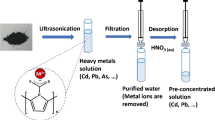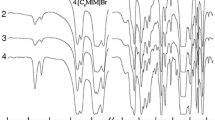Abstract
A small low-power humidifier with a simple programmable on/off switch was used as a pulsed ultrasound generator. Using this tool, a novel sonochemiluminescence (SCL) method was developed to determine bentazone. To the best of our knowledge, no chemiluminescence method has been proposed to determine this pesticide. Only five studies have been proposed for SCL quantitative applications so far. Therefore, revealing new aspects of SCL promises to develop analytical methods for the quantitative determination of different substances. A molecularly imprinted polymerized high internal phase emulsion (MIP-polyHIPE) was synthesized, bentazone separated from aqueous solutions, and pre-concentrated by the MIP-polyHIPE foam. The adsorption of bentazone on the MIP-polyHIPE adsorbent was theoretically studied by density functional theory through molecular dynamics simulation. Both experimental and simulation results indicated removal and pre-concentration of bentazone by the MIP-polyHIPE adsorbent. Using the proposed SCL method and without pre-concentration process, a linear dynamic range (LDR) of 2.5 × 10−7–5.0 × 10−5 mol L−1 and a limit of detection (LOD) of 8.4 × 10−8 mol L−1 were obtained for bentazone with a relative standard deviation of 2.64%. The LDR and LOD were improved to 2.6 × 10−9–2.0 × 10–7 mol L−1 and 8.8 × 10−10 mol L−1, respectively, using MIP-polyHIPE adsorbents. The method’s application was evaluated by removing and pre-concentration of bentazone from water samples, including well, river, and tap water. The results showed that the pre-concentration factor and recovery percentages were 113–131 times and 93–106%, respectively, using the MIP-polyHIPE absorbent.
Graphical abstract









Similar content being viewed by others
Data availability
Not applicable.
Code availability
Not applicable.
References
Fernandez Rivas D, Ashokkumar M, Leong T et al (2012) Sonoluminescence and sonochemiluminescence from a microreactor. Ultrason Sonochem 19:1252–1259. https://doi.org/10.1016/j.ultsonch.2012.04.008
Harvey EN (1939) Sonoluminescence and sonic chemiluminescence. J Am Chem Soc 61:2392–2398. https://doi.org/10.1021/ja01878a037
Nie Y, Chen J, Yan Y, Lv J (2010) Flow-sonochemiluminescence method for antioxidant capacity analysis. Food Chem 122:360–365. https://doi.org/10.1016/j.foodchem.2010.02.048
Dharmarathne L, Ashokkumar M, Grieser F (2012) Photocatalytic generation of hydrogen using sonoluminescence and sonochemiluminescence. J Phys Chem C 116:1056–1060. https://doi.org/10.1021/jp209946s
McMurray HN, Wilson BP (1999) Mechanistic and spatial study of ultrasonically induced luminol chemiluminescence. J Phys Chem A 103:3955–3962. https://doi.org/10.1021/jp984503r
Meng C, Du F, Abdussalam A et al (2021) Sonochemiluminescence using apertureless USB piezoelectric ultrasonic transducer and its applications for the detection of hydrogen peroxide, glucose, and glucose oxidase activity. Anal Chem 93:14934–14939. https://doi.org/10.1021/ACS.ANALCHEM.1C03834/SUPPL_FILE/AC1C03834_SI_001.PDF
Lai Y, Qi Y, Wang J, Chen G (2009) Using acridinium ester as the sonochemiluminescent probe for labeling of protein. Analyst 134:131–137. https://doi.org/10.1039/B813330A
Sharipov GL, Abdrakhmanov AM (2010) Sonochemiluminescence of aromatic hydrocarbons. Russ Chem Bull 59:1680–1685. https://doi.org/10.1007/s11172-010-0296-8
Kulmala S, Ala-Kleme T, Latva M et al (1996) Sonoluminescence of chelated terbium(III) in aqueous solution. J Chem Soc Faraday Trans 92:2529. https://doi.org/10.1039/ft9969202529
Sharipov GL, Abdrakhmanov AM, Gareev BM, Yakshembetova LR (2018) Sonochemiluminescence in an aqueous solution of Ru(bpy)3Cl2. Ultrason Sonochem 42:526–531. https://doi.org/10.1016/j.ultsonch.2017.12.013
Marmottant P, Hilgenfeldt S (2003) Controlled vesicle deformation and lysis by single oscillating bubbles. Nature 423:153–156. https://doi.org/10.1038/nature01613
Wang J, Lai Y, Chen M et al (2013) Kinetics of luminol sonochemiluminescence quenched by purines. Luminescence 28:102–107. https://doi.org/10.1002/bio.2345
ZHANG Xiao-li,HU Yue LJ (2009) Sonochemiluminescence determination of scavenging active oxygen of tea extract. J Shaanxi Norm Univ Sci Ed 51–53
Du F, Ma X, Yuan F et al (2020) Sonochemiluminescence based on a small, cheap, and low-power USB mesh-type piezoelectric ultrasonic transducer. Anal Chem 92:4755–4759. https://doi.org/10.1021/acs.analchem.0c00042
Andersson LI, Paprica A, Arvidsson T (1997) A highly selective solid phase extraction sorbent for preconcentration of sameridine made by molecular imprinting. Chromatographia. https://doi.org/10.1007/BF02490930
Hu M, Ge W, Liu X, Zhu Y (2022) Preconcentration and determination of zearalenone in corn oil by a one-step prepared polydopamine-based magnetic molecularly imprinted polymer (MIP) with high-performance liquid chromatography with fluorescence (HPLC-FLD) detection. Anal Lett. https://doi.org/10.1080/00032719.2021.1931268
Ilktaç R, Gümüş ZP (2020) Magnetite-molecularly imprinted polymer based highly sensitive chromatographic method for preconcentration and determination of pirimicarb. Int J Environ Anal Chem. https://doi.org/10.1080/03067319.2020.1804890
Mokhtari A, Barati M, Karimian H, Keyvanfard M (2022) A molecularly imprinted polymerized high internal phase emulsion adsorbent for sensitive chemiluminescence determination of clopidogrel. Spectrochim Acta Part A Mol Biomol Spectrosc 265:120371. https://doi.org/10.1016/j.saa.2021.120371
Mirata F, Resmini M (2015) Molecularly imprinted polymers for catalysis and synthesis. Adv Biochem Eng Biotechnol 150:107–129. https://doi.org/10.1007/10_2015_319
Wulff G (2002) Enzyme-like catalysis by molecularly imprinted polymers. Chem Rev 102:1–28. https://doi.org/10.1021/cr980039a
Yoshikawa M, Tharpa K, Dima Ş-O (2016) Molecularly imprinted membranes: past, present, and future. Chem Rev 116:11500–11528. https://doi.org/10.1021/acs.chemrev.6b00098
Wackerlig J, Schirhagl R (2016) Applications of molecularly imprinted polymer nanoparticles and their advances toward industrial use: a review. Anal Chem 88:250–261. https://doi.org/10.1021/acs.analchem.5b03804
Wang HJ, Zhou WH, Yin XF et al (2006) Template synthesized molecularly imprinted polymer nanotube membranes for chemical separations. J Am Chem Soc 128:15954–15955. https://doi.org/10.1021/ja065116v
Schirhagl R (2014) Bioapplications for molecularly imprinted polymers. Anal Chem 86:250–261. https://doi.org/10.1021/ac401251j
Ye L, Mosbach K (2001) Molecularly imprinted microspheres as antibody binding mimics. React Funct Polym 48:149–157. https://doi.org/10.1016/S1381-5148(01)00050-5
Ebarvia BS, Binag CA, Sevilla III F (2004) Biomimetic piezoelectric quartz sensor for caffeine based on a molecularly imprinted polymer. Anal Bioanal Chem 378:1331–1337. https://doi.org/10.1007/s00216-003-2433-9
Chen L, Li B (2013) Magnetic molecularly imprinted polymer extraction of chloramphenicol from honey. Food Chem 141:23–28. https://doi.org/10.1016/j.foodchem.2013.02.085
Bai J, Chen L, Zhu Y et al (2021) A novel luminescence sensor based on porous molecularly imprinted polymer-ZnS quantum dots for selective recognition of paclitaxel. Colloids Surf A Physicochem Eng Asp 610:125696. https://doi.org/10.1016/j.colsurfa.2020.125696
Cao J, Shen C, Wang X et al (2021) A porous cellulose-based molecular imprinted polymer for specific recognition and enrichment of resveratrol. Carbohydr Polym 251:117026. https://doi.org/10.1016/j.carbpol.2020.117026
Wu Y, Ma Y, Pan J et al (2017) Porous and magnetic molecularly imprinted polymers via pickering high internal phase emulsions polymerization for selective adsorption of λ-cyhalothrin. Front Chem 5:18. https://doi.org/10.3389/fchem.2017.00018
Lloyd LL, Millichip MI, Watkins JM (2002) Reversed-phase poly(styrene-divinylbenzene) materials optimised for large scale preparative and process purification of synthetic peptides and recombinant proteins. J Chromatogr A 944:169–177. https://doi.org/10.1016/S0021-9673(01)01238-9
Akat H, Saltan F (2015) Synthesis, characterization and thermal degradation of cross-linked polystyrene using the alkyne-functionalized esters as a cross-linker agent by click chemistry method. Polimeros 25:402–407. https://doi.org/10.1590/0104-1428.1950
Li Y, Fan Y, Ma J (2001) Thermal, physical and chemical stability of porous polystyrene-type beads with different degrees of crosslinking. Polym Degrad Stab 73:163–167. https://doi.org/10.1016/S0141-3910(01)00083-0
Aldemir Dikici B, Claeyssens F (2020) Basic principles of emulsion templating and its use as an emerging manufacturing method of tissue engineering scaffolds. Front Bioeng Biotechnol 8:875. https://doi.org/10.3389/fbioe.2020.00875
WHO (2017) Bentazone in drinking-water background document for development of WHO Guidelines for Drinking-water Quality
Singh-Verma SB, Luib M (1974) Bentazon - a new herbicide for chemical weed control in soya beans. PANS Pest Artic News Summ 20:129–132. https://doi.org/10.1080/09670877409412358
Cotruvo JA (2017) 2017 WHO guidelines for drinking water quality: first addendum to the fourth edition. J Am Water Works Assoc 109:44–51. https://doi.org/10.5942/jawwa.2017.109.0087
Pohanish RP (2014) Sittig’s handbook of pesticides and agricultural chemicals, Second Edi. William Andrew, Norwich, USA
Bakhsh H, Buledi JA, Ghumro T et al (2021) Sodium dodecyl sulfate stabilized NiO nanoseeds: a potential procedure for ultra-sensitive determination of bentazone in vegetables. J Mater Sci Mater Electron 3212(32):15917–15929. https://doi.org/10.1007/S10854-021-06143-7
Buledi JA, Buledi PA, Batool M et al (2021) Exploring electrocatalytic proficiencies of CuO nanostructure for simultaneous determination of bentazone and mexacarbate pesticides. Appl Nanosci 11:1889–1902. https://doi.org/10.1007/s13204-021-01864-x
Mutharani B, Ranganathan P, Tsai HC, Lai JY (2021) Synthesis of hierarchically porous 3D polymeric carbon superstructures with nitrogen-doping by self-transformation: a robust electrocatalyst for the detection of herbicide bentazone. Microchim Acta. https://doi.org/10.1007/s00604-021-04910-1
Minhua L, Technology OG-WP, 2012 U (2012) Determination of bentazone, atrazine and 2, 4-D in water by HPLC with solid-phase extraction. Water Purif Technol 2:72–75
Mo W, Liu J, Cheng M et al (2011) Determination of 2, 4-D, bentazone and atrazine in water by high performance liquid chromatography. J Environ Heal 28:532–534
Rivoira L, De Carlo RM, Cavalli S, Bruzzoniti MC (2015) Simple SPE–HPLC determination of some common drugs and herbicides of environmental concern by pulsed amperometry. Talanta 131:205–212. https://doi.org/10.1016/j.talanta.2014.07.070
Fuhrmann A, Gans O, Weiss S et al (2014) Determination of bentazone, chloridazon and terbuthylazine and some of their metabolites in complex environmental matrices by liquid chromatography-electrospray ionization-tandem mass spectrometry using a modified QuEChERS method: an optimization and vali. Water Air Soil Pollut 225:1944. https://doi.org/10.1007/s11270-014-1944-7
Cho B, Kim S, In S, Choe S (2017) Simultaneous determination of bentazone and its metabolites in postmortem whole blood using liquid chromatography–tandem mass spectrometry. Forensic Sci Int 278:304–312. https://doi.org/10.1016/j.forsciint.2017.07.024
Li L, Yin Y, Zheng G et al (2021) Determination of multiclass herbicides in sediments and aquatic products using QuECHERS combined with ultra-high performance liquid chromatography-tandem mass spectrometry (UHPLC-MS/MS) and its application to risk assessment of rice-fish co-culture system. Microchem J. https://doi.org/10.1016/j.microc.2021.106628
Qiu L, Deng J (2013) Simultaneous determination of glyphosate, 2, 4-D and bentazone in drinking water by ion chromatography. Guangdong Agric Sci 2:93–98
Porini JA, Escandar GM (2011) Spectrofluorimetric study of the herbicide bentazone in organized media: analytical applications. Anal Methods 3:1494–1500. https://doi.org/10.1039/c1ay05028a
Tölgyesi Á, Korozs G, Tóth E et al (2022) Automation in quantifying phenoxy herbicides and bentazon in surface water and groundwater using novel solid phase extraction and liquid chromatography tandem mass spectrometry. Chemosphere 286:131927. https://doi.org/10.1016/j.chemosphere.2021.131927
Gareev BM, Yakshembetova LR, Abdrakhmanov AM, Sharipov GL (2019) Mechanism of the Ru(bpy)32+ single-bubble sonochemiluminescence in neutral and alkaline aqueous solutions. J Lumin. https://doi.org/10.1016/j.jlumin.2018.12.033
Tsukahara K, Umemura S, Yoshizawa S (2021) Effect of ultrasonic intensity and intervals of ultrasonic exposure on efficiency of sonochemiluminescence in gel phantom for sonodynamic therapy. Jpn J Appl Phys 60:SDDE12. https://doi.org/10.35848/1347-4065/abf4a4
Nozaki K, Hatanaka SI, Hayashi S (2004) Dynamics of single sonoluminecsing bubble in concentrated aqueous alkaline halide solutions. Japanese J Appl Physics Part 1 Regul Pap Short Notes Rev Pap 43:6481–6483. https://doi.org/10.1143/JJAP.43.6481
Jin J, Kumeta H, Takahashi F, Asakura Y (2009) Sensitive detection of hydroxyl radical production in ultrasonic field with an electrochemiluminescence optical sensor. Chem Lett 38:292–293. https://doi.org/10.1246/cl.2009.292
Barati AH, Mokhtari-Dizaji M, Mozdarani H et al (2006) Free hydroxyl radical dosimetry by using 1 MHz low level ultrasound waves. Iran J Radiat Res 3:163–169
Tuziuti T, Yasui K, Lee J et al (2008) Mechanism of enhancement of sonochemical-reaction efficiency by pulsed ultrasound. J Phys Chem A 112:4875–4878. https://doi.org/10.1021/jp802640x
Berberidou C, Kitsiou V, Kazala E et al (2017) Study of the decomposition and detoxification of the herbicide bentazon by heterogeneous photocatalysis: kinetics, intermediates and transformation pathways. Appl Catal B Environ 200:150–163. https://doi.org/10.1016/j.apcatb.2016.06.068
Jevtić S, Stefanović A, Stanković DM et al (2018) Boron-doped diamond electrode — a prestigious unmodified carbon electrode for simple and fast determination of bentazone in river water samples. Diam Relat Mater 81:133–137. https://doi.org/10.1016/j.diamond.2017.12.009
Geto A, Noori JS, Mortensen J et al (2019) Electrochemical determination of bentazone using simple screen-printed carbon electrodes. Environ Int 129:400–407. https://doi.org/10.1016/j.envint.2019.05.009
Wang D, Shi L, Analysis NS-CJ of, 2012 U (2012) Determination of bentazone residues in soil, rice and straw by QuEChERS-HPLC. Chinese J Anal Lab 31(6):1–5
Kim Y, Lee S, Song L, et al (n.d.) Analytical method of bentazone residue in agricultural commodities using HPLC-UVD/MS. Korean J Pestic Sci 15:149–159
Zhang J, Yan S, Gu J et al (2013) Determination of bentazone and 2, 4-D in water by liquid-liquid extraction/high performance liquid chromatography. China Water Wastewater 29:100–105
Funding
Golestan University supported the present study.
Author information
Authors and Affiliations
Contributions
Conceptualization, Writing—original draft, Writing—review & editing, Supervision [Ali Mokhtari], Data curation, Investigation [Zohreh Akbarzadeh]. Project administration [Hossein Karimian], Formal Analysis [Ghasem Bahlakeh].
Corresponding author
Ethics declarations
Ethics approval and consent to participate
Not applicable.
Consent for publication
Not applicable.
Conflict of interest
The authors declare no competing interests.
Additional information
Publisher's note
Springer Nature remains neutral with regard to jurisdictional claims in published maps and institutional affiliations.
Supplementary Information
Below is the link to the electronic supplementary material.
Rights and permissions
Springer Nature or its licensor holds exclusive rights to this article under a publishing agreement with the author(s) or other rightsholder(s); author self-archiving of the accepted manuscript version of this article is solely governed by the terms of such publishing agreement and applicable law.
About this article
Cite this article
Akbarzadeh, Z., Mokhtari, A., Bahlakeh, G. et al. Pulsed-sonochemiluminescence combined with molecularly imprinted polymerized high internal phase emulsion adsorbent for determination of bentazone. Microchim Acta 189, 302 (2022). https://doi.org/10.1007/s00604-022-05406-2
Received:
Accepted:
Published:
DOI: https://doi.org/10.1007/s00604-022-05406-2




